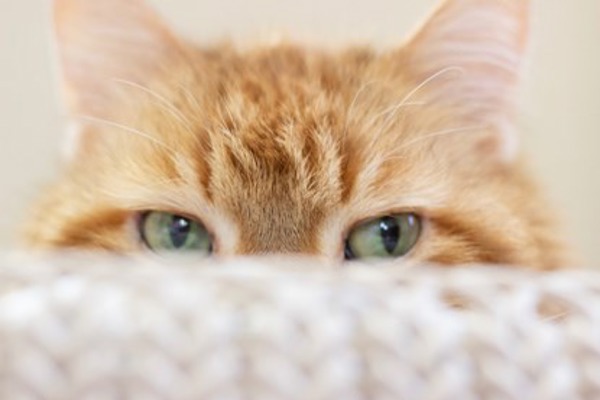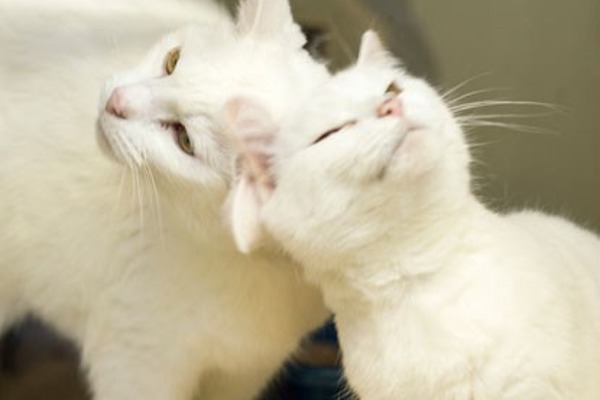Behaviour Manager Nicky Trevorrow explains why cats in the same household may not always get along and how you can help them to become 'friends'.
As part of last week’s feline friend or foe campaign, behaviour expert Nicky Trevorrow hosted a very special live Q&A on our national Facebook page. Do you have more than one cat? Are you wondering if they’re friends or foes? Or are you looking for tips to help them get along better?
Here are just some of the multi-cat household questions Nicky answered:
How can I encourage all my cats to get along?
I have four cats. Two of them get on quite well, and one of them only gets on with two of them. But none of them really gel as a family, they tolerate each other! Is there anything I can do to help them get along?
As long as they tolerate each other rather than showing signs that they are stressed like cats blocking resources from other cats (eg one cat feels like they can't use a litter tray while another is around), then that's fine.
Have a look at their use of space. Draw a house plan and mark on where each of the four cats is spending time. Then give separate resources per cat in the different areas that you've identified as their territories.
For readers who want to understand their cats’ social groups, try doing an ‘interaction diagram’ for your cats. These are often used by behaviourists to explore feline relationships in more depth. Start by observing the cats and noting their behaviours in a table.
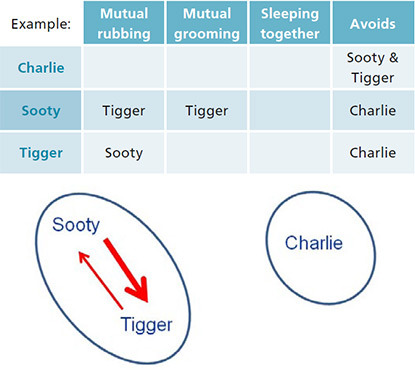
Interaction diagram; first appeared in The Cat magazine, Autumn 2015
This interaction diagram shows that Sooty and Tigger are in the same social group and Charlie is a separate social group. The thicker arrow from Sooty towards Tigger shows that he likes Tigger more!
Once the number of social groups has been identified, the best way of helping to keep the peace is by providing plenty of essential feline resources; litter trays, food bowls, water bowls, hiding places etc. In an ideal world, one resource per cat plus one extra gives the cats choice. As a minimum though, provide enough resources per social group. If you have one cat living upstairs and another downstairs, then split the resources between the respective areas. It will reduce any competition between the cats as well as reduce the stress of one cat coming downstairs through another cat’s territory in order to access food.
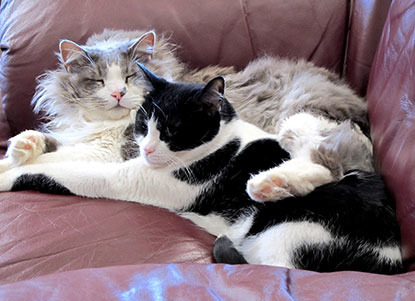
Photo by frankieleon via flickr / Creative Commons
Will my cats ever get on?
I have two 11-year-old female cats and have just adopted two one-year-old males. After five weeks I still cannot leave them together in the same room because of hissing and growling from both camps (no actual fighting though). Do you think they'll ever get on with each other? And at what stage do you give up?
It sounds like you may need to re-start a slow introduction programme. Keep the cats separate for the time being and start the scent swapping stage again. You’ll need to get a clean cloth and rub it on their cheeks where the scent glands are and then leave the cloth in the middle of the floor with the other cats to investigate. But also ensure that all cats are healthy as stress can manifest itself in lots of different medical conditions. For more information, check out my recent blog post on integrating cats and Cats Protection’s guide to introducing cats to each other.
As for how long to leave it for, this is a really difficult question to answer as it varies between groups, the resources and space available, the severity of the conflict for the cats, etc. After five weeks of trying already, it may be best to get a qualified behaviourist in to meet your cats and advise. We'd recommend a referral to a member of the Association of Pet Behaviour Counsellors (APBC) www.apbc.org.uk
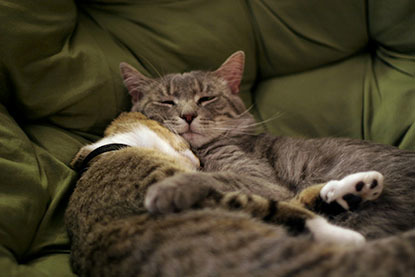
Photo by Andrew Butitta via flickr / Creative Commons
Why are my cats jealous of each other?
I’ve had my cat Sabrina for over a year and recently got a male ginger cat called Alfie. Both are lovely cats but they ‘argue’ all the time. Sabrina is very jealous of the attention I give Alfie and vice versa. Alfie eats Sabrina’s food if left unattended so we have to put it up high. Any tips on how to get them to be friends?
It's really good that you're putting Sabrina's food up high and I would suggest that you continue this. Many owners think that their cats are jealous, but interestingly cats don't have 'jealousy' in their emotional repertoire. Instead cats are territorial and want enough resources for themselves. This even includes you as they want fussing and attention from you. What I'd recommend is giving both cats separate interactive play sessions with a fishing rod toy (store away after use for safety) so they each get quality time with you. Share out the play sessions with anyone else living in or visiting the house.
Provide both cats with lots of resources, ideally one per cat plus one extra. If you're still struggling to keep the peace, then we'd recommend a referral to a member of the Association of Pet Behaviour Counsellors (APBC) – see link above. Best of luck!
Please note that we are unable to give specific advice on your cat's health or any change in behaviour observed. For medical problems consult your vet who will have access to your cat’s medical history and will be able to examine them.
Would you like to ask one of Cats Protection’s feline experts a question about your cat? Don’t miss the next live Facebook Q&A sessions: CP vet Vanessa Howie will answer veterinary questions on 8 October; neutering expert Jane Clements will host the Q&A on 19 October; while Behaviour Manager Nicky Trevorrow returns on 5 November. All our Q&As are held on Cats Protection's national Facebook page from 2-3pm. See you there!

